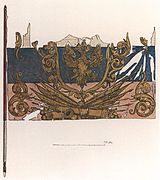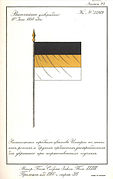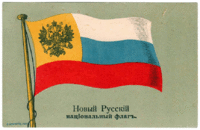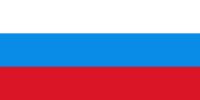Представлено сочинение на английском языке Флаг России/ Flag of Russian Federation с переводом на русский язык.
| Flag of Russian Federation | Флаг России |
| Flag is the country’s main symbol as well as the anthem and coat of arms. The flag of Russia consists of three stripes – white, blue and red. There is no official version of what the colours mean but some people believe that the white colour stands for generosity, blue for loyalty, and red for courage. Another symbolism is: white represents God that is at the top, red is peasants at the bottom, and blue is a tsar which is between the two. | Флаг – главный символ страны наряду с гимном и гербом. Флаг России состоит из трех полос – белой, синей и красной. Нет официальной версии, что именно означают цвета, но некоторые говоря, что белый – символ щедрости, синий – преданности, а красный – отваги. Другой вариант: белый представляет Бога, на самом верху, красный – крестьян, внизу, а синий – это царь, который находится между ними. |
| The history of the flag comes from the 1697 when Tsar Peter I visited the Netherlands. He liked the simple design of Dutch flag and used the same colours for the Russian flag. In 1917 in the period of October revolution, the flag was changed for the Red Flag that contained a gold hammer, sickle, and gold-bordered red star. It was the official flag of the Soviet Union. But later on August 21, 1991 the original white-blue-red Russian national flag was restored. | История флага началась в 1967 году, когда царь Петр I посетил Нидерланды. Ему понравился простой дизайн нидерландского флага, и он использовал такие же цвета для российского флага. В 1917 году в период Октябрьской революции, флаг сменили на Красный Флаг, состоявший из золотого молота, серпа и красной звезды с золотым контуром. Это был официальный флаг Советского Союза. Но позже, 21 августа 1991 года, был восстановлен оригинальный бело-сине-красный флаг. |
| In 1994 the National Flag Day was established in Russia. It is celebrated on 22 August, but people work on this day. The flag is also raised on every national holiday. | В 1994 году был установлен Национальный День Флага. Его отмечают 22го августа, но люди работают в этот день. Флаг поднимают в день каждого государственного праздника. |
Инфоурок
›
Другое
›Презентации›Презентация по английскому языку «National Flag of the Russian Federation» (6 класс)
Скачать материал

Скачать материал


- Курс добавлен 24.10.2022
- Сейчас обучается 93 человека из 38 регионов


- Сейчас обучается 105 человек из 44 регионов


аудиоформат
- Сейчас обучается 93 человека из 41 региона


Описание презентации по отдельным слайдам:
-
1 слайд
National flag of the Russian Federation
-
2 слайд
The day of the national flag of the Russian Federation is celebrated annually on August 22. It was established in 1994 by the decree of the President of the Russian Federation.
-
3 слайд
День Государственного флага Российской Федерации отмечается ежегодно 22 августа. Он был установлен в 1994 году указом президента Российской Федерации.
-
4 слайд
Meaning of flag colors
White color symbolizes nobility and frankness;
Blue color-loyalty, honesty, perfection and chastity;
Red color-courage, courage, generosity and love. -
5 слайд
Значение цветов флага
Белый цвет символизирует благородство и откровенность;
Синий цвет — верность, честность, безупречность и целомудрие;
Красный цвет — мужество, смелость, великодушие и любовь. -
6 слайд
The flag of Russia (National flag of the Russian Federation) is one of the official state symbols of the Russian Federation, along with the emblem and anthem. It is a rectangular cloth of three equal horizontal stripes: top-white, middle-blue and bottom-red. The ratio of the flag width to its length is 2: 3
-
7 слайд
Флаг России (Госуда́рственный флаг Росси́йской Федера́ции) — один из официальных государственных символов Российской Федерации, наряду с гербом и гимном. Представляет собой прямоугольное полотнище из трёх равновеликих горизонтальных полос: верхней — белого, средней — синего и нижней — красного цвета. Отношение ширины флага к его длине составляет 2:3.
Краткое описание документа:
Российский флаг бело-сине-красного цвета окончательно утвердили в 1991 году. Начиная с 1994 года, когда президент подписал соответствующий указ, ежегодно 22 августа традиционно отмечается день флага России.В настоящее время символ государства способствует воспитанию патриотизма, уважения к родному краю, дает ощущение духовного и кровного единства. Государственный флаг имеет огромное значение в международных отношениях.
Найдите материал к любому уроку, указав свой предмет (категорию), класс, учебник и тему:
6 058 134 материала в базе
- Выберите категорию:
- Выберите учебник и тему
- Выберите класс:
-
Тип материала:
-
Все материалы
-
Статьи
-
Научные работы
-
Видеоуроки
-
Презентации
-
Конспекты
-
Тесты
-
Рабочие программы
-
Другие методич. материалы
-
Найти материалы
Материал подходит для УМК
Другие материалы
Вам будут интересны эти курсы:
-
Курс профессиональной переподготовки «Клиническая психология: организация реабилитационной работы в социальной сфере»
-
Курс повышения квалификации «Основы построения коммуникаций в организации»
-
Курс профессиональной переподготовки «Логистика: теория и методика преподавания в образовательной организации»
-
Курс повышения квалификации «Применение MS Word, Excel в финансовых расчетах»
-
Курс профессиональной переподготовки «Теория и методика преподавания иностранных языков: английский, немецкий, французский»
-
Курс профессиональной переподготовки «Организация менеджмента в туризме»
-
Курс профессиональной переподготовки «Теория и методика преподавания иностранных языков в профессиональном образовании: английский, немецкий, французский»
-
Курс повышения квалификации «Методы и инструменты современного моделирования»
-
Курс профессиональной переподготовки «Организация деятельности секретаря руководителя со знанием английского языка»
-
Курс профессиональной переподготовки «Организация процесса страхования (перестрахования)»
-
Курс профессиональной переподготовки «Управление качеством»
-
Скачать материал
-
13.10.2018
8804
-
PPTX
2.6 мбайт -
64
скачивания -
Рейтинг:
5 из 5 -
Оцените материал:
-
-
Настоящий материал опубликован пользователем Дериева Евгения Геннадьевна. Инфоурок является
информационным посредником и предоставляет пользователям возможность размещать на сайте
методические материалы. Всю ответственность за опубликованные материалы, содержащиеся в них
сведения, а также за соблюдение авторских прав несут пользователи, загрузившие материал на сайтЕсли Вы считаете, что материал нарушает авторские права либо по каким-то другим причинам должен быть удален с
сайта, Вы можете оставить жалобу на материал.Удалить материал
-
- На сайте: 5 лет и 2 месяца
- Подписчики: 5
- Всего просмотров: 394773
-
Всего материалов:
326
22 августа Россия отмечает один из своих национальных праздников — День государственного флага. (August 22, Russia celebrates one of its National holidays: the Flag Day.) It was officially established in 1994 to celebrate the victory over putschists in 1991. Though it is a national holiday, it is not a day-off.
Государственный флаг Российской Федерации состоит из трёх равновеликих горизонтальных полос: верхней — белого, средней — синего и нижней — красного цвета. (The national flag of the Russian Federation has three equal horizontal stripes: white on top, blue in the middle and red on the bottom.)
The white, blue and red flag was first used as an ensign на первом русском военном корабле “Орёл” (on board of the first Russian warship “Eagle”) in 1667 during the reign of Alexis of Russia (1629-1676).
При Петре I триколор играет роль государственного флага и поднимается уже на всех кораблях российского флота. (Under Peter the Great, the three colours played the role of national flag and could be seen on the entire Russian fleet.)
Но в 1806 году появилась новая традиция. (But in 1806 a new tradition appeared.) A Russian expedition explored the southern part of the Sakhalin and raised two flags on the shores: Андреевский флаг отмечал заслугу военного флота (the St. Andrew’s flag representing the merit of the navy) and государственный бело-сине-красный флаг — новое владение России. (the national blue-white-red flag representing the new ownership of Russia.)
Following the October Revolution and the victory of the Bolsheviks, the three colours flag was discarded and a new red flag with communist symbols was introduced and remained until the collapse of the Soviet Union.
One flag, several interpretations
There are many theories about the origin of the three colours. One popular theory suggests that the order in which the colours were placed reflected the Russian social system while under the monarchy: white represents God, blue represents the Tsar and red represents the people.
According to another version, it originated from the coat of arms of the Grand Duchy of Moscow, St. Georges all dressed in his silver armour and mounted a white horse, with a blue cape hanging on his shoulders and holding a blue shield is riding on a red field.
Some says that these three colours are associated with the robes of the Virgin Mary, the holy protectress of Russia.
Another interpretation associates white with the bright future, blue with clouded present and red with bloody past.
По другой версии, белый цвет означал благородство, синий — честность, а красный — смелость и великодушие, присущее русским людям. (It is also said that white represents the nobility, blue the honesty and red the courage and generosity inherent to Russian people.)
August 22, Russia celebrates one…
Сочинение на английском языке «Российский флаг»
The national flag of Russia consist of three horizontal stripes of red on the bottom, blue in the middle and white on the top. Those colours are considered to be Pan-Slavic. Russian government has never assigned any official meaning to the colors of the national flag. It was adopted in the middle of 17th century.
The Origins of the Flag of Russia
According to one theory, the colors of the flag came from the Grand Duchy of Moscow and depict Saint George in a silver armor, on a white horse, wearing a blue cap on a red field. Another theory states that white color is a symbol of God, blue of Tsar and red of peasants. Another theory states that white stands for a bright future, blue for clouded present and red for the bloody past. The 22nd of August is officially a Flag Day in Russia.
Peter the Great chose such flag for Russia because he was very fond of Holland. Nevertheless, it first appeared during the reign of the first tsar of the Romanov dynasty, Mikhail Fedorovich. In 1634, the court of Mikhail Fedorovich embassy arrived from Holstein Friedrich III. In addition to diplomatic issues, the embassy has also decided the question of the construction of ten ships to travel to Persia. The first ship, «Frederick», was launched in 1636. His term of shipboard life was short-lived, but he went under the Holstein flag suspiciously like our current tricolor. Alexis chose this flag for the first Russian frigate As the team consisted entirely of frigates of the Dutch, so without hesitation, it was decided to put a flag identical to the Dutch.
Former Russian Flags
At the times of Ivan the Terrible the traditional flag was red with the image of Christ. In 1552, Russian troops marched under it on the victorious assault on Kazan. The flag of Tsar Alexiei Michilovich was deeply symbolic. Musketeer banners inspired it. It is based on the Cross.Thus, this flag indicates the mission of Russia in the universe, as the last speaker on the true faith — Orthodoxy.
The flag of the Romanov dynasty had three colours – black, yellow and white). It was introduced in the Decree of Alexander II of June 11, 1858.The developer of the flag was probably B.Kene. Black-yellow-white flag is based on the Russian heraldic tradition. Its black color stands for two-headed eagle, yellow for gold fields and white is the color of communication.
The first person who used the tricolor in the USSR was Garry Kasparov. During the world championship match with Anatoly Karpov (who played under the Soviet flag), Kasparov made a red, white and blue flag. Everything was changing and Garry obviously felt how and where the wind was blowing. Kasparov, by the way, won that match. A year later new flag established.
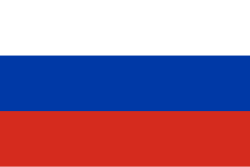 |
|
| Триколор (Trikolor; Tricolour) |
|
| Use | Civil and state flag, civil and state ensign |
|---|---|
| Proportion | 2:3 |
| Adopted |
1696–1923
1991–present
|
| Design | A horizontal tricolour of white, dark blue and red |
| Designed by | Peter the Great |
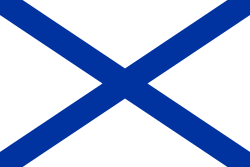
Variant flag of Russia |
|
| Use | Naval ensign |
| Proportion | 2:3 |
| Adopted | 1712–1923 1992–present |
| Design | St. Andrew’s Cross with a white background and two blue diagonal bands forming a saltire. |
The national flag of Russia (Russian: Флаг России, romanized: Flag Rossii), also known as the State Flag of the Russian Federation (Russian: Государственный флаг Российской Федерации, romanized: Gosudarstvenny flag Rossiyskoy Federatsii), is a tricolour flag consisting of three equal horizontal fields: white on the top, blue in the middle, and red on the bottom. The flag was first used as an ensign for Russian merchant ships in 1696.
It remained in use until 1858, when the first official flag of the Russian Empire was decreed by Alexander II, which was a tricolour consisting of three horizontal fields: black on the top, yellow in the middle, and white on the bottom. A decree in 1896 reinstated the white, blue, and red tricolour as the official flag of the Russian Empire until the Revolution of 1917.
Following the creation of the Russian Socialist Federative Soviet Republic after the Bolshevik Revolution, the Russian tricolour was abolished, but its usage was preserved by the White Movement and the Russian state during the Russian Civil War. During the Soviet Union’s existence, the country used the red flag with a golden hammer and sickle and a golden bordered red star on top while the Russian SFSR (a constituent republic of the USSR) used a defaced variant with a vertical blue bar at the hoist.
During the dissolution of the Soviet Union, after the 1991 August Coup, the Russian SFSR adopted a new flag design similar to the pre-revolutionary tricolour that had been abolished in 1917. The ratio of the new flag was 1:2, and the flag colours consisted of white on the top, blue in the middle, and red on the bottom. When Boris Yeltsin made the State Heraldic Register, he gave the flag the number 1 there. The flag design remained the same until 1993, when the original Russian tricolour was fully restored as the current flag after the 1993 Russian constitutional crisis.[citation needed] The current flag is listed at number 2 in the SHR.
Origin[edit]
Two accounts of the flag’s origin connect it to the tricolour used by the Dutch Republic (the flag of the Netherlands).[1][2]
The earliest mention of the flag occurs during the reign of Alexis I, in 1668, and is related to the construction of the first Russian naval ship, the frigate Oryol. According to one source, the ship’s Dutch lead engineer Butler faced the need for the flag, and issued a request to the Boyar Duma, to «ask His Royal Majesty as to which (as is the custom among other nations) flag shall be raised on the ship». The official response merely indicated that, as such issue is as yet unprecedented, even though the land forces do use (apparently different) flags, the tsar ordered that his (Butler’s) opinion be sought about the matter, asking specifically as to the custom existing in his country.[3]
A different account traces the origins of the Russian flag to tsar Peter the Great’s visits to Arkhangelsk in 1693 and 1694. Peter was keenly interested in shipbuilding in the European style, different from the barges ordinarily used in Russia at the time. In 1693, Peter had ordered a Dutch-built frigate from Amsterdam. In 1694 when it arrived, the Dutch red, white, and blue banner flew from its stern.[4] Peter decided to model Russia’s naval flag after that banner by assigning meaning and reordering the colours.
The Dutch flag book of 1695 by Carel Allard,[5] printed only a year after Peter’s trip to Western Europe, describes the tricolour with a double-headed eagle bearing a shield on its breast and wearing a golden crown over both of its heads.
History[edit]
-
-
National flags of Russia
before and after 1896 -
-
A study on clarifying the national colours of Russia based on disquisition on documents of the Moscow Archive of Ministry of Justice of the Russian Empire was summarized by Dmitry Samokvasov, a Russian archaeologist and legal historian, in an edition of 16 pages called «On the Question of National Colours of Ancient Russia» published in Moscow in 1910.[6]
1552–1918: Tsardom, Empire and Republic[edit]
Banner of the «Most Gracious Saviour» under Ivan the Terrible
In 1552, Russian regiments marched on the victorious assault of Kazan under Ivan the Terrible with the banner of the Most Gracious Saviour. For the next century and a half, the banner of Ivan the Terrible accompanied the Russian army. Under Tsarina Sophia Alekseevna, it visited the Crimean campaigns, and under Peter the Great, the Azov campaigns and the Russo-Swedish War.
In the Illustrated Chronicle of Ivan the Terrible, there is an image of the banner of Ivan the Terrible in the Kazan campaign – a bifurcated white one with the image of the Saviour and an eight-pointed cross above it. According to other sources, the banner was red instead of white. A copy of this banner, which has been restored many times, is still kept in the Kremlin Armoury.
In 1612, the Nizhny Novgorod militia raised the banner of Dmitry Pozharsky, it was crimson in colour with the image of the Lord Almighty on one side and the archangel Michael on the other.
The armorial banner of Peter the Great, 1696
In 1669, the Polish painters Stanislav Loputsky and Ivan Mirovsky invited by Tsar Alexis of Russia, painted for the tsar’s palace in Kolomenskoye «the hallmarks (that is, the emblems) of the sovereigns and all the universal states of this world.» Then Loputsky drew «on the canvas, the coat of arms of the Moscow State and the arms of other neighbouring countries, under every emblem of the planet under which they are.» The coat of arms was a white rectangular banner with a «slope» and a wide red border, in the centre of which was depicted a gold two-headed eagle and the emblems symbolizing the subject kingdoms, principalities and lands. In the inventory of the Kremlin Armoury, the coat of arms is described as the following: «In the circle there is a two-headed eagle wearing two crowns, and in his chest, the king on horseback pricks a serpent with his spear».[7]
On 6 August 1693, during Peter the Great’s sailing in the White Sea with a detachment of warships built in Arkhangelsk, the so-called «Flag of the Tsar of Muscovy»[8] was raised for the first time on the 12-gun yacht «Saint Peter». The flag was a cross-stitch of 4.6×4.9 meters sewn from cloth, composed of three equal-sized horizontal stripes of white, blue and red, with a golden double-headed eagle in the middle.[9] The original of this oldest surviving Russian flag is located in the Central Naval Museum in Saint Petersburg.
A 1695 flag book[10] by Carel Allard describes three flags used by the tsar of Muscovy: the tricolour[11] with the double-headed eagle bearing a shield on its breast and wearing a golden crown over both of its heads, the same tricolour[12] with a blue saltire over it, and a cross flag[13] showing red and white quartering with a blue cross over all.[14] The cross flag is depicted upon the Construction of Kronschloss Medal,[15] which commemorates the construction of Fort Kronschlot (Kronschloss) in Kronstadt by Peter the Great in 1704, the colours of the flag being determined according to the hatchings engraved.
The armorial banner of Peter the Great was created in 1696. Made from red taffeta with a white border, the flag depicted a golden eagle hovering over the sea. On the chest of the eagle in the circle is the Saviour, next to the Holy Spirit and the Holy Apostles Peter and Paul. The banner was likely made for the second Azov campaign.[16]
Taking the fortress of Azov. 1696 by Adrian Shkhonebek
In 1693, Franz Timmerman received the order to build merchant ships in Arkhangelsk and trade with Europe. He was told to display the two-headed eagle spread with wings, with three crowns over it. On the chest of the eagle, a warrior on horseback was to be displayed with a spear, in a military harness. The same eagle was also to hold a sceptre with the right leg and an apple with a crest with the left. The same instructions were given to other traders.[17]
Russian flag (lower right) on the Practice battle on the river IJ in honour of Peter I, September 1697. Painting by Abraham Storck, 1700
According to Dutch newspapers, in June 1694, a 44-gun frigate bought by Russia and built in Rotterdam stood in the Amsterdam roadstead under the white-blue-red flag.[18]
In 1696, at the mouth of the river Don, a Russian flotilla of armed rowboats blocked the supply of the Ottoman fortress of Azov. On the 1700 engraving by Adrian Shkhonebek, Taking the fortress of Azov. 1696, depicts the ships carrying rectangular panels on the flagpoles, the heraldic shading of which shows that some of the flags are blue with a straight red cross, and the rest are white with a straight red cross. A number of researchers doubt the accuracy of Shkonebek’s engraving because he was not a witness to the events.[19]
Images of various white-blue-red Russian flags are present in the three later paintings of Abraham Storck’s workshop dedicated to the arrival in Amsterdam of Peter I. Peter I took part in a practice battle on the river IJ while on board the yacht of the Dutch East India Company.[20] In the paintings of Abraham Stork depicting the show fight, this yacht sails under the white-blue-red flag with a double-headed eagle, or under a white-red-blue pennant and a white-red-blue aft flag with a double-headed eagle.
In October 1699, Peter I, on the back of the sheet with instructions sent to the Russian envoy Yemelyan Ukraintsev in Istanbul, drew a sketch of a three-band white-blue-red flag.[21]
In December 1699, the Austrian ambassador Anton Paleyer gave a list of weapons and flags seen on the vessels of the Azov Flotilla in a letter. He described seeing three small flags of white-red-blue colours and two regimental colours of red and white mixed in with other colours.[22]
In April 1700, Peter I ordered the Kremlin Armoury to build white-red-violet sea banners.[23] The design and dimensions of these banners correspond to the figure and the size of the regimental banner kept among the other 352 trophy Russian banners in the burial vault of Swedish kings – the Riddarholm Church in Stockholm.[24]
The three-band white-blue-red flag, as well as the flag with a red Jerusalem cross, were also used on warships up to 1720 as signals.[25]
-
Practice battle on the river IJ in honor of Peter I, Abraham Storck, Amsterdam Museum[26]
-
Flag with a Jerusalem Cross, 1693
-
White-red-violet banners ordered by Peter I and captured by Swedes during the Battle of Narva in 1700
-
Philipp Heinrich Müller, Construction of Kronschloss Medal, 1704
-
Black-and-white sketch of the flag, 1885
-
Order by Tsar Alexander II on the official flag of the Russian Empire
Russian flag during WWI on a postcard (1914–1917)[a]
The Russian tricolour flag was adopted as a merchant flag at rivers in 1705. These colours of the flag of Russia would later inspire the choice of the «Pan-Slavic colours» by the Prague Slavic Congress, 1848. Two other Slavic countries, Slovakia and Slovenia, have flags similar to the Russian one, but with added coats-of-arms for differentiation. On 7 May 1883, the Russian flag was authorized to be used on land, and it became an official National flag before the coronation of Tsar Nicholas II in 1896.
The flag continued to be used by the Russian Provisional Government after the Tsar was toppled in the February Revolution and was not replaced until the October Revolution which established the Russian Socialist Federative Soviet Republic.
1918–1991: Civil War and Soviet Union[edit]
Flag of the Russian SFSR (1918–1937)
Flag of the Russian SFSR (1937–1954)
Flag of the Russian SFSR (1954–1991)
On 8 April 1918, the flag of the Russian Soviet Federative Socialist Republic was discussed at a meeting of the Council of People’s Commissars of the RSFSR. The Council proposed that the All-Russian Central Executive Committee create a red flag with the abbreviation for the phrase Workers of the world, unite! However, the proposal was not adopted. On 13 April 1918, the All-Russian Central Executive Committee established the RSFSR flag to be a red banner with the inscription Russian Socialist Federative Soviet Republic. The text of the decree did not contain any clarification regarding the colour, size and location of the inscription, or the width and length ratio of the cloth.
On 17 June 1918, the All-Russian Central Executive Committee approved a sample image of the flag of the RSFSR, developed on behalf of the People’s Commissariat for Foreign Affairs of the Russian SFSR by the graphic artist Sergey Chekhonin. The flag was a red rectangular panel, in the upper corner of which was placed the inscription RSFSR in gold letters stylized as Slavic. This inscription was separated from the rest of the cloth on both sides by gold stripes forming a rectangle.
On 30 December 1922, the RSFSR combined with the Ukrainian SSR, Byelorussian SSR, and Transcaucasian SFSR to form the Soviet Union. The national flag of the USSR was established on 18 April 1924, described in the Constitution of the USSR as a red or scarlet rectangular cloth with a 1:2 width to length ratio, with a gold sickle and hammer in the top corner next to the flagpole and a red five-pointed star framed with a golden border. This flag was carried by all ships of the USSR and diplomatic representations of the USSR. The 1:2 red flag was used, until replaced in 1954 with the universal design of the Soviet flag with a blue stripe along the mast.
Contrary to the belief that the USSR state flag outranked the flag of the RSFSR, the actual use of the USSR flag was limited. The USSR flag in Russia flew only over two buildings, that of the Central Executive Committee of the Soviet Union and the Council of People’s Commissars. That decision was adopted on 23 March 1925, also establishing that the flag of the RSFSR had to be raised constantly not only on the buildings of the Central Executive Committee and the Council of People’s Commissars but also on the buildings of all local soviets, including village soviets and district soviets in cities. On holidays, the RSFSR flag had to be raised on many public buildings (such as schools, hospitals, and government offices).[27]
During the Second World War, the white-blue-red tricolour was used by Nazi collaborators, most of whom were from groups targeted by the repressions of the Stalin era, including anti-communist Christians and the remnants of the Kulaks, who generally regarded the Nazi invasion as a liberation of Russia from communism to preserve White Christendom. Thus, in the war, the troops known as the Russian Liberation Army, led by Andrey Vlasov, who was allied with Germany against the Soviet Union, flew the tricolour flag, as well as the St Andrew’s Flag, as they fought against the Soviet Army.[28][29]
On 20 January 1947, the Presidium of the Supreme Soviet of the USSR found it necessary to amend the national flags of the allied republics so that the flags reflected the idea of a Soviet Union state as well as the unique national identities of the republics. On each of the flags was placed the emblem of the USSR, a sickle and a hammer with a red five-pointed star, with the inclusion of national ornaments and new colours.[30] The new RSFSR flag was established in January 1954: a red rectangular panel with a light blue strip near the pole running the full width of the flag. In the upper left corner of the red canvas were depicted a golden sickle and a hammer and above them a red five-pointed star framed with a golden border. By the Law of the RSFSR of 2 June 1954, this flag was approved and the description of the flag was included in Article 149 of the Constitution of the RSFSR.[31]
1991–present: Russian Federation[edit]
During the dissolution of the Soviet Union, after the 1991 August Coup, the Russian SFSR adopted a new flag design similar to the pre-revolutionary tricolour that had been abolished in 1917. The ratio of the new flag was 1:2, and the flag colours consisted of white on the top, blue in the middle, and red on the bottom. The flag design remained the same until 1993, when the original Russian tricolour was fully restored as the current flag after the 1993 Russian constitutional crisis.[citation needed] Following the events of the attempted coup in Moscow, the supreme soviet of the Russian SFSR declared, by resolution dated 22 August 1991,[32] that the old imperial tricolour flag serve as the national flag of the state. The constitution was subsequently amended by Law No. 1827-1 1 November 1991.[33] At the disintegration of the USSR on 25 December 1991, the Soviet flag was lowered from Kremlin and then replaced by the tricolour flag.
The modern era flag underwent a proportion change from 1:2 to 2:3 in 1993 and has been most recently provided for by a 2000 law.[34] On 11 December 1993, President of the Russian Federation Boris Yeltsin signed Decree No. 2126 «On the State Flag of the Russian Federation».[35] In Article 1 of the decree, the flag was described as a «rectangular panel of three equal horizontal stripes: the top – white, middle – blue, and bottom – red, with a width to length ratio of 2:3.»
The National Flag Day is an official holiday in Russia, established in 1994. It is celebrated on 22 August, the day of the victory over putschists in 1991, but employees remain at work.
Symbolism[edit]
At the times of Alexander III of Russia the official interpretation was as follows: the white color symbolizes nobility and frankness; the blue for faithfulness, honesty, impeccability, and chastity; and the red for courage, generosity, and love. A common unofficial interpretation was: Red: Great Russia, White: White Russia, Blue: Little Russia.[36]
Regulations[edit]
When the Russian flag and the flags of the Russian federal subjects are flown at the same time, the national flag should be:
- on the left if two flags are raised
- in the middle if the number of flags is odd
- and to the left of the centre if the number is even
The flag cannot be smaller, or lower than a regional flag.[37]
Colour specifications[edit]
Specifications for the flag of Russia
Federal constitutional law of the Russian Federation only says that the colours of the flag are «white», «blue» (синий, or dark blue, as Russian has two colours that are called «blue» in English), and «red». The Federal Constitutional Law on the State Flag of the Russian Federation does not actually specify which shades the colours should be. Russian government agencies when ordering the manufacture of cloth for the flag indicate the following Pantone colours: white, blue (Pantone 286C), and red (Pantone 485C).[38][39][40]
| Scheme | White | Blue | Red |
|---|---|---|---|
| RAL | 9016 | 5005 | 3028 |
| Pantone | White | 286 C | 485 C |
| RGB | 255–255–255 | 0–50–160[41] | 218–41–28[42] |
| CMYK | 0–0–0–0 | 100–80–0–12[41] | 0–95–100–00[42] |
| HTML | #FFFFFF | #0032A0 | #DA291C |
Colour specifications for different colour shades[edit]
| Scheme | White | Blue | Red |
|---|---|---|---|
| Pantone | White | 280 C | 180 C |
| RGB | 255–255–255 | 1–20–122 | 195–52–36 |
| CMYK | 0–0–0–0 | 99–84–0–52 | 0–73–82–24 |
| HTML | #FFFFFF | #01147A | #C33424 |
The album of national flags, published by the Hydrographic and Oceanographic Service of the Russian Navy, gives the following shades of colours of the flag of Russia in Pantone:[43]
| Scheme | White | Blue | Red |
|---|---|---|---|
| Pantone | White | 293C | 485C |
The colours following are for the old, Post-Soviet flag of Russia:
Colors scheme |
White | Azure | Scarlet |
|---|---|---|---|
| RAL | 9016 | 5012 | 3020 |
| CMYK | 0-0-0-0 | 100-39-0-9 | 0-94-85-14 |
| HEX | #FFFFFF | #018DE9 | #DB0D20 |
| RGB | 255-255-255 | 1-141-233 | 219-13-32 |
Variant versions[edit]
Flag of the Tsar, c.17th century
Presidential standard
A variant of the flag was authorized for private use by Tsar Nicholas II before World War I, adding the large state eagle on a yellow field (imperial standard) in the canton. It has never been used as the official state flag. Likewise, today some Russian people may use another variant of the flag defaced with the double-headed eagle from the coat of arms in the middle and the golden word РОССИЯ at the bottom.[44]
After the October Revolution of 1917, the tricolour design was banned, and a definitive new flag of the RSFSR (one of the constituent republics of the Soviet Union) was introduced in 1954 (see flag of Russian SFSR), and this remained the republic’s flag until the collapse of the Soviet Union in 1991. All of the Soviet Republics’ flags were created by introducing a small but noticeable change to the flag of the Soviet Union. For Russia, the change was an introduction of the left-hand blue band. The previous Soviet design was different, a plain red flag with different variants of the «RSFSR» abbreviation in the canton. Today, the Soviet flag is used by the supporters and members of the Communist Party of the Russian Federation.
The tricolour was used by the anticommunist forces during the Civil War called the White movement. It was continued to be used by White émigrés in various countries as the Russian flag. The tricolour was associated both in Soviet Russia as well as the Russian White emigre communities as symbolizing a traditional tsarist Orthodox Russia. It, as well as the naval ensign of the Imperial Russian Navy was used by anticommunist Russian troops under German command during the Second World War. Both flags can be seen inside a few Orthodox churches in the West established by the Russian communities. In the Soviet Union, this flag was used in films set in the prerevolutionary period and was seen as a historical flag, especially after the 1940s.
It, rather than the black-yellow-white colour combination, was readopted by Russia on 22 August 1991. That date is celebrated yearly as the national flag day.[citation needed]
The President of Russia uses a Presidential Standard (Russian: Штандарт Президента), which was introduced via Presidential Decree No.319 on 15 February 1994, it is officially defined as the square tricolour with the coat of arms (in this case the double-headed eagle is depicted without the shield) in the middle.[45][46]
Unicode[edit]
The Flag of Russia is represented as the Unicode emoji sequence U+1F1F7 🇷 REGIONAL INDICATOR SYMBOL LETTER R and U+1F1FA 🇺 REGIONAL INDICATOR SYMBOL LETTER U, making «🇷🇺».[47]
See also[edit]
- Coat of arms of Moscow
- Coat of arms of Russia
- Flags of the federal subjects of Russia
- List of Russian flags
- Flag of the Russian-American Company
- Pan-Slavic colours
- Flag of Dagestan (nearly identical design, green stripe instead of white)
- Flag of the Donetsk People’s Republic (nearly identical design, black stripe instead of white)
- Flag of Colombia (nearly identical design, yellow stripe instead of white)
- Flag of the Luhansk People’s Republic (nearly identical design, turquoise stripe instead of white)
- Flag of Slovakia (nearly identical design, defaced with the coat of arms at the hoist side)
- Flag of Slovenia (nearly identical design, defaced with the coat of arms at the hoist side)
- Flag of Transnistria
- White-blue-white flag (variant used by anti-war protesters against the invasion of Ukraine)
Notes[edit]
- ^ Introduced in 1914 as a flag «for private use» to support patriotism during the war. Plans to formally adopt this design after the war were abolished after the fall of the monarchy.
References[edit]
- ^ Hulme, Frederick Edward (1 January 1897). The Flags of the World: Their History, Blazonry and Associations. Library of Alexandria. ISBN 9781465543110.
- ^ Greenway, H. D. S. (2014). Foreign Correspondent: A Memoir. Simon and Schuster. p. 228. ISBN 978-1-4767-6132-9.
- ^ Flag T.H. Eriksen & R. Jenkins, Nation and Symbolism in Europe and America. Abingdon, 2007, p. 23
- ^ Robert K. Massie, Peter the Great, 160 (Modern Library Edition 2012)
- ^ «Nieuwe Hollandse scheeps-bouw, Amsteldam: C. Allard, 1695». Internet Archive contributed by National Library of the Netherlands. Allard, Carel. 1695.
- ^ Самоквасов Д. Я. К вопросу о государственных цветах древней России. — М.: тип. Саблина, 1910. — 16 с. Russian State Library
- ^ Государственная символика (in Russian). Archived from the original on 2 April 2015. Retrieved 29 June 2013.
- ^ Central Naval Museum, St. Petersburg. List of exhibited artefacts. Flag of the Tsar of Muscovy.
- ^ Белавенец П. И. Флаг Царя Московского, хранившийся в кафедральном соборе города Архангельска с 1693 года / Бюллетень Управления геральдики Государственной архивной службы Российской Федерации. Вып. No. 1, октябрь 1993 г., — С. 3
- ^ «Nieuwe Hollandse scheeps-bouw, waar in vertoond word een volmaakt schip, met alle des zelfs uitterlyke deelen … Benevens de afbeeldingen van alle de voornaamste vlaggen … Carel Allard». Allard, Carel. 1695.
- ^ «Nieuwe Hollandse scheeps-bouw, waar in vertoond word een volmaakt schip, met alle des zelfs uitterlyke deelen … Benevens de afbeeldingen van alle de voornaamste vlaggen … Carel Allard». Allard, Carel. 1695.
- ^ «Nieuwe Hollandse scheeps-bouw, waar in vertoond word een volmaakt schip, met alle des zelfs uitterlyke deelen … Benevens de afbeeldingen van alle de voornaamste vlaggen … Carel Allard». Allard, Carel. 1695.
- ^ «Nieuwe Hollandse scheeps-bouw, waar in vertoond word een volmaakt schip, met alle des zelfs uitterlyke deelen … Benevens de afbeeldingen van alle de voornaamste vlaggen … Carel Allard». Allard, Carel. 1695.
- ^ Russian flags at Flags of the World
- ^ «Construction of Kronschloss Medal, 1704». Pushkin State Museum of Fine Arts, Coins and Medals Department.
- ^ Н. А. Соболева, В. А. Артамонов (1993). Символы России (in Russian). Панорама. p. 208. ISBN 5-85220-155-3.
- ^ Елагин С. Наши флаги. / Морской сборник, т. LXVIII, 1863, No. 10 – С. 231
- ^ Басов А. Н. История военно-морских флагов. — М.: Аст, СПб.: Полигон, 2004, ISBN 5-17-022747-7, С.46
- ^ Оленин Р. М., Карманов В. В. От первого корабля до первого Устава. История морских флагов России (1669–1725 гг.). — СПб.: «Шатон», 2006. — С. 54
- ^ Uiterst links een jacht met de Russische vlag en tsaar Peter de Grote aan boord, gekleed in het rood (Слева – яхта под флагом России с царём Петром I на борту, одетым в красное). Het Spiegelgevecht op het IJ ter ere van het Moskovisch gezantschap (1 September 1697), 1697–1700
- ^ Устрялов Н. Г. История царствования Петра Великого. Т. IV. — СПб., 1863. Карты, планы и схемы. — С. 15 (копия листа с приложения No. 14)
- ^ Елагин С. И. История русского флота. Период Азовский. Приложения. Ч. 1. — СПб., 1864 – С. 428–429
- ^ Яковлев Л.П. (1865). Древности Российскаго государства, изданныя по высочайшему повелению. Доп. к 3 отд-нию: Русския старинныя знамена. М. p. 110.
- ^ П. И. Белавенец. Краткая записка о старых русских знамёнах. — СПб, 1911. С.33
- ^ Оленин Р. М., Карманов В. В. От первого корабля до первого Устава. История морских флагов России (1669–1725 гг.). — СПб.: «Шатон», 2006. — С. 207
- ^ Het Spiegelgevecht op het IJ ter ere van het Moskovisch gezantschap (1 September 1697), 1697–1700
- ^ Собрание узаконений и распоряжений правительства РСФСР. — 1925, No. 20, цит. по: Вексиллологический справочник по флагам Российской Империи и СССР, Т.1/сост. Соколов В. А. — М.: МГИУ, 2002, ISBN 5-276-00240-1, СС.487–488
- ^ Lilia Shevtsova: Putin’s Russia. Carnegie Endowment, 2010. p. 114
- ^ Kathleen E. Smith: Mythmaking in the New Russia: Politics and Memory During the Yeltsin Era. Cornell University Press, 2002. p. 160
- ^ Центральный Государственный архив Киргизской ССР, ф.1445, оп.3, д.29, л.2, цит. по: Вексиллологический справочник по флагам Российской Империи и СССР, Т.1/сост. Соколов В. А. — М.: МГИУ, 2002, ISBN 5-276-00240-1, СС.399–400
- ^ Закон РСФСР от 2 июня 1954 г. «О Государственном флаге РСФСР»
- ^ per Resolution No. 1627/1-I of the Supreme Soviet of the RSFSR of 22 August 1991
- ^ per Law No. 1827-1 of the RSFSR of 1 November 1991
- ^ per Decree No. 2126 of 11 December 1993
- ^ О Государственном флаге Российской Федерации : Указ Президента РФ от 11 December 1993 No. 2126 // Собрание актов Президента и Правительства Российской Федерации. 1993. No. 51. Ст. 4928.
- ^ Государственный флаг России. Статья на сайте Политического консультативного центра
- ^ «State Insignia». State Insignia. Retrieved 6 September 2022.
- ^ Федеральная служба охраны (14 December 2011). «Запрос котировочной цены. Характеристика поставляемых товаров». Archived from the original on 16 August 2012. Retrieved 8 August 2012.
- ^ Управление делами Президента России. «Госзаказ на изготовление и поставку штандартов Президента. Технические требования». Archived from the original on 16 August 2012. Retrieved 8 August 2012.
- ^ Министерство обороны Российской Федерации. «Приложение № 2 к тендеру от 12 марта 2010 года. Техническое задание на изготовление Комплекта флагов, копий исторических знамён и штандартов фронтов, а также элементов знамённого (флажного) комплекса для проведения парада, посвящённого празднованию 65-летия Победы в Великой Отечественной войне 1941—1945 гг». Archived from the original on 16 August 2012. Retrieved 8 August 2012.
- ^ a b Pantone 286 C
- ^ a b Pantone 485 C
- ^ Service Hydrographique et Oceanographique de la Marine (2010) [Album des pavillons : pavillons et marques distinctives]. Альбом национальных флагов (Edition 2000 — Correction n°5 — 2010 ed.). Marselle, France: Librairie Maritime Outremer. Archived from the original on 21 April 2012.
- ^ Unofficial flag of Russia at Flags of the World
- ^ per Decree No. 319 of 15 February 1994
- ^ Flag of the president of Russia at Flags of the World
- ^ «🇷🇺 Flag for Russia Emoji». Retrieved 2 January 2018.
External links[edit]
- Official image of the Russian flag, on the official site of the Russian President
- Federal Constitutional Law of 25 December 2000 No. 1-FKZ «On the State Flag of the Russian Federation» (including amendments). pravo.gov.ru (in Russian)
- Timeline Russian National Flag (in Italian)
- Flag of Russia – old link (in Russian)
- Flag of Russia – Vexillographia (in Russian)
- Flag of Russia (in Russian)
- National Flag and Naval Ensign in Russia Navy (in Russian)


- Entertainment & Pop Culture
- Geography & Travel
- Health & Medicine
- Lifestyles & Social Issues
- Literature
- Philosophy & Religion
- Politics, Law & Government
- Science
- Sports & Recreation
- Technology
- Visual Arts
- World History
- On This Day in History
- Quizzes
- Podcasts
- Dictionary
- Biographies
- Summaries
- Top Questions
- Week In Review
- Infographics
- Demystified
- Lists
- #WTFact
- Companions
- Image Galleries
- Spotlight
- The Forum
- One Good Fact
- Entertainment & Pop Culture
- Geography & Travel
- Health & Medicine
- Lifestyles & Social Issues
- Literature
- Philosophy & Religion
- Politics, Law & Government
- Science
- Sports & Recreation
- Technology
- Visual Arts
- World History
- Britannica Classics
Check out these retro videos from Encyclopedia Britannica’s archives. - Demystified Videos
In Demystified, Britannica has all the answers to your burning questions. - #WTFact Videos
In #WTFact Britannica shares some of the most bizarre facts we can find. - This Time in History
In these videos, find out what happened this month (or any month!) in history. - Britannica Explains
In these videos, Britannica explains a variety of topics and answers frequently asked questions.
- Student Portal
Britannica is the ultimate student resource for key school subjects like history, government, literature, and more. - COVID-19 Portal
While this global health crisis continues to evolve, it can be useful to look to past pandemics to better understand how to respond today. - 100 Women
Britannica celebrates the centennial of the Nineteenth Amendment, highlighting suffragists and history-making politicians. - Britannica Beyond
We’ve created a new place where questions are at the center of learning. Go ahead. Ask. We won’t mind. - Saving Earth
Britannica Presents Earth’s To-Do List for the 21st Century. Learn about the major environmental problems facing our planet and what can be done about them! - SpaceNext50
Britannica presents SpaceNext50, From the race to the Moon to space stewardship, we explore a wide range of subjects that feed our curiosity about space!












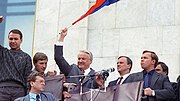

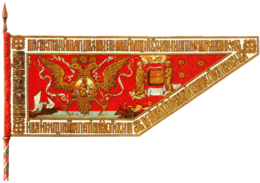
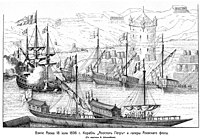

![Practice battle on the river IJ in honor of Peter I, Abraham Storck, Amsterdam Museum[26]](https://upload.wikimedia.org/wikipedia/commons/thumb/a/ac/SA_22993-Het_Spiegelgevecht_op_het_IJ_ter_ere_van_het_Moskovisch_gezantschap_%281_september_1697%29-Spiegelgevecht_op_het_IJ_op_1_september_1697_ter_ere_van_het_bezoek_van_Tsaar_Peter_de_Grote.jpg/180px-thumbnail.jpg)

